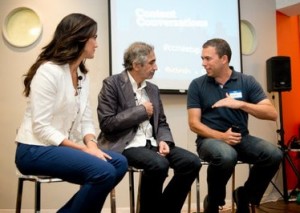Brands
The New Newsroom: How Content Connects Editorial and Marketing at Forbes
The intersection of new and traditional publishing was under examination last week at the second Content Conversations at Outbrain’s New York offices.

Annalisa Camarillo of NetApp and Lewis D’Vorkin of Forbes Media (center) talk with Outbrain CEO Yaron Galai at the meetup.
Lewis D’Vorkin, chief product officer at Forbes, and Annalisa Camarillo, senior manager of Executive Engagement Programs for NetApp, maker of digital data-storage tools and software, were the speakers at the Sept. 19 event, hosted by Outbrain and Contently.
D’Vorkin and Camarillo both spoke about creating content through their companies’ perspective. They’re creating it together. But only one is a traditional publisher.
NetApp started publishing news and analysis to Forbes’ website just this year. The arrangement came together under the AdVoice sponsorship campaign — an advertiser package that Forbes rolled out in 2010, allowing brands to post articles of their own directly to the Forbes homepage.
The idea is an increasingly familiar recipe when it comes to content marketing. Camarillo said NetApp wants to reach readers in a news-rich environment, so that they will associate the brand with high-quality and useful information.
“We don’t necessarily talk about our company and our brand,” said Camarillo of what NetApp delivers.
NetApp’s pieces are not advertorials. Consider the headline: “Germany Warns Against Internet Explorer; Should CIOs Take Heed?” or “Are Smartphones Making Us Dumber?” This is the kind of material that stands up to almost any bar set by the in-house articles on Forbes’ homepage.
Camarillo said NetApp’s writers and editors are working to “earn the marketplace’s respect, to be heard, and then, as we are respected and establish a relationship with it on Forbes, then we can start to take them to the next level.”
‘Vital Voices’: Marketing’s place on the homepage
“At Forbes, we believe that there are three vital voices that are in the media as it exists today,” said D’Vorkin. “Obviously there are journalists; our agenda — the Forbes agenda. There’s also the social agenda.”
The social agenda is clear on the Forbes home page. Starting at the in-house byline dominated top, when readers reach its approximate middle they find the Most Popular section. Headlines are corralled in this middle spot according to on-site user views, by how often a story is shared on platforms such as Facebook, and as a result of comment totals following the piece wherever it lives at Forbes.com.
“And there’s also the individual agenda,” D’Vorkin said, meaning users and what they look for during a reading experience. At the Forbes site, individuals can implement their “agenda” via the Follow feature, a selection tool on the front page.
Then D’Vorkin added a fourth vital voice: the AdVoice driven content.
Marketing communities have always played a key role in any media enterprise, he explained.
“But their content through ads has always been placed in silos along the side. It’s very important to source those vital voices on these home pages,” he said. “By placing their voice on our homepage, it shows the importance that the marketing voice has. Because the reality is, marketers are experts just like journalists are experts … in the world of digital publishing.”
Building the new newsroom
Camarillo said, in an interview after the panel, that the investment in AdVoice comes with a minimum $1 million ad package buy-in. That’s a typical scenario, according to a recent article in AdAge.
Forbes has also recently allowed companies to come into the arrangement for a $50,000–$100,000 per month licensing fee.
Apart from the financing, D’Vorkin said at the panel, the deal develops along editorial lines. Whether it’s Forbes working with NetApp or any other AdVoice client, the structure promises new discoveries, he said.
“For the last two years we have been building what I would call the new newsroom,” D’Vorkin said. “The new newsroom is one of data analysis, it’s one of audience development, it’s one of producers educating new journalistic content creators about how to have that conversation.”
“What our sales team is doing is, now, creating a mirror desk for brands,” he said. “Those people have the same disciplines: audience development, business headline writing, data analysis … We created this model in editorial, we’ve moved it to the brand desk, and the learning that we get to share with the brand desk, well, I might add that the brand desk will have its own learnings that they can pass along to the editorial desk. Two separate teams that report up to two different areas, but we can learn from each of them.”
Image courtesy of Noam Galai
Get better at your job right now.
Read our monthly newsletter to master content marketing. It’s made for marketers, creators, and everyone in between.




